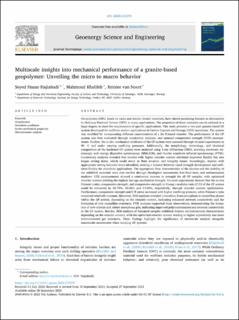| dc.identifier.citation | Hajiabadi, S.H., Khalifeh, M. & Van Noort, R. (2023) Multiscale insights into mechanical performance of a granite-based geopolymer: Unveiling the micro to macro behavior. Geoenergy Science and Engineering, 231, part A, 212375 | en_US |
| dc.description.abstract | Geopolymers (GPs), based on rocks and similar (waste) materials, have shown promising features as alternatives to Ordinary Portland Cement (OPC) in many applications. The properties of these materials can be tailored to a large degree, to meet the requirements of specific applications. This study presents a two-part granite-based GP system developed for wellbore sealant applications in Carbon Capture and Storage (CCS) operations. The system was modified by incorporating different concentrations of a Zn–K-based retarder. The performance of the GP system was then evaluated through consistency analyses, and uniaxial compressive strength (UCS) measurements. Further, the in-situ mechanical attributes of the GP system were assessed through tri-axial experiments at 90 °C and under varying confining pressures. Additionally, the morphology, mineralogy, and chemical composition of the hardened GP system were analyzed using X-ray diffraction (XRD), scanning electronic microscopy with energy dispersive spectroscopy (SEM-EDS), and Fourier transform infrared spectroscopy (FTIR). Consistency analyses revealed that slurries with higher retarder content exhibited improved fluidity but also longer setting times, which could result in fluid invasion and integrity issues. Accordingly, slurries with appropriate setting behavior were identified, striking a balance between rapid strength development and sufficient fluidity for downhole applications. The appropriate flow characteristics of the slurries and the stability of the solidified materials were also verified through rheological assessments, free-fluid tests, and sedimentation analyses. UCS measurements showed a continuous increase in strength for all GP samples, with optimized retarder content yielding the highest late-age mechanical strength. Tri-axial experiments showed that the in-situ Poisson's ratio, compressive strength, and compressive strength to Young's modulus ratio (C/E) of the GP system could be enhanced by 86.79%, 40.26% and 13.05%, respectively, through retarder content optimization. Furthermore, compressive strength and C/E ratios increased with higher confining pressure, while Poisson's ratio remained relatively constant. Moreover, XRD analyses revealed a transition from amorphous to crystalline phases within the GP system, depending on the retarder content, indicating enhanced network connectivity and the formation of new crystalline structures. FTIR analyses supported these observations, demonstrating the formation of new crystals and robust amorphous gels, indicating improved polycondensation and network connectivity in the GP system. Besides, SEM analysis of fractured samples exhibited distinct microstructural characteristics depending on the retarder content, with the optimized retarder content leading to higher crystallinity and more interconnected gel structures. These findings highlight the significance of microscale analysis alongside macroscale assessments when studying GP systems. | en_US |

